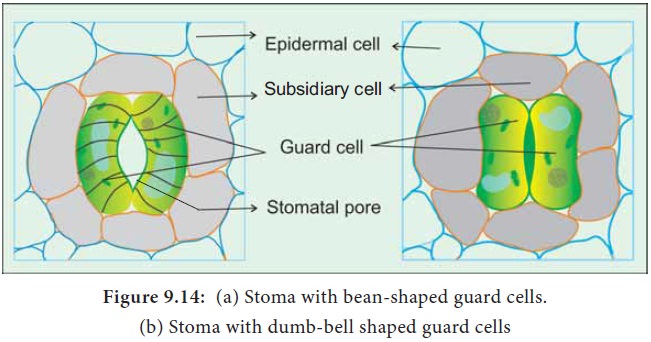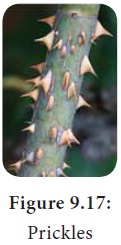Chapter: 11th Botany : Chapter 9 : Tissue and Tissue System
Epidermal Tissue System
Epidermal Tissue System
Introduction
Epidermal
tissue system is the outer most covering of plants. It
is in direct contact with external environment. It consists of epidermis
derived from protoderm. Epidermis is derived from two Greek words, namely ‘Epi’
and ‘Derma’. ‘Epi’ means upon and
‘Derma’ means skin. Although epidermis is a continuous outer layer,
it is interrupted by stomata in many plants.
Root Epidermis
The outer
layer of the root is known as piliferous layer or epiblema. It is made up of single layer of parenchyma cells
which are arranged compactly without intercellular spaces. It is devoid of
epidermal pores and cuticle. Root hair is always single celled, it absorbs
water and mineral salts from the soil. The another important function of piliferous layer is protection.
Stem Epidermis
It is
protective in function and forms the outermost layer of the stem. It is a
single layer of parenchymatous rectangular cells. The cells are compactly
arranged without intercellular cells. The outer walls of epidermal cells have a
layer called cuticle. The cuticle
checks transpiration . The cuticle is
made up of cutin. In many plants it
is also mixed wax to form epicuticular wax. Epidermal pores may be present here
and there. Epidermal cells are living. Chloroplasts are usually absent except
in guard cells of stomata. In many plants a large number of epidermal hairs
occur on the epidermis.
Leaf Epidermis
The leaf
is generally dorsiventral. It has
upper and lower epidermis. The epidermis is usually made up of a single layer
of cells that are closely packed. Generally the cuticle on the upper epidermis
is thicker than that of lower epidermis. The minute openings found on the
epidermis are called stomata (singular: stoma). Usually,
stomata are more in number on the lower epidermis than on the upper epidermis.
A stoma is surrounded by a pair of specialized epidermal cells called guard
cells. In most dicots and monocots the guard cells are bean-shaped. While in
grasses and sedges, the guard cells are dumbbell- shaped. The guard cells
contain chloroplasts, whereas the other epidermal cells normally do not have
them.

Some
cells of upper epidermis (Example: Grasses) are larger and thin walled. They
are called bulliform cells or motor cells. These cells are helpful
for the rolling and unrolling of the leaf according to the weather change. Some
of the epidermal cells of the grasses are filled with silica. They are called silica cells.
Subsidiary Cells
Stomata
are minute pores surrounded by two guard cells. The stomata occur mainly in the
epidermis of leaves. In some plants addition to guard cells, specialised
epidermal cells are present which are distinct from other epidermal cells. They
are called Subsidiary cells. Based
on the number and arrangement of subsidiary cells around the guard cells, the
various types of stomata are recognised. The guard cells and subsidiary cells
help in opening and closing of stomata during gaseous exchange and transpiration.
Sunken Stomata
In some
Xerophytic plants (Examples: Cycas, Nerium), stomata is sunken beneath the
abaxial leaf surface within stomatal crypts. The sunken stomata reduce water
loss by transpiration.
Multilayered or Multiseriate Epidermis
Generally,
epidermis is single layered, but in certain leaves, multilayered upper
epidermis is present, Example: Ficus, Nerium, and Peperomea.
In Ficus upper epidermal layer contains
cystoliths made up of calcium carbonate crystals.

In Nerium , in the multilayered epidermis
the outer layer alone is cutinized.
Epidermal Outgrowths
There are
many types of epidermal outgrowths in stems. The unicellular or multicellular
appendages that originate
Trichomes may be branched or unbranched
and are one or more one celled thick. They assume many shapes and sizes. They
may also be glandular (Example: Rose,
Ocimum) or non-glandular.
Piliferous
layer of the root has two types of epidermal cells, long cells and short cells.
The short cells are called trichoblasts.
Trichoblasts
are elongate into root hairs. Epidermal hairs can also be in the form of
stellate hairs (star shaped) present in plants. Example: styrax, many members
of Malvaceae and Solanaceae.

Prickles
Prickles,
are one type of epidermal emergences with no vascular supply. They are stiff
and sharp in appearance. (Example: Rose).

Functions of Epidermal Tissue System
1.
This system in the shoot checks excessive loss of
water due to the presence of cuticle.
2.
Epidermis protects the underlying tissues.
3.
Stomata is involved in transpiration and gaseous
exchange.
4.
Trichomes are also helpful in the dispersal of
seeds and fruits, and provide protection against animals.
5.
Prickles also provide protection against animals
and they also check excessive transpiration
6.
In some rose plants they also help in climbing.
7.
Glandular hairs repel herbivorous animals.
Related Topics